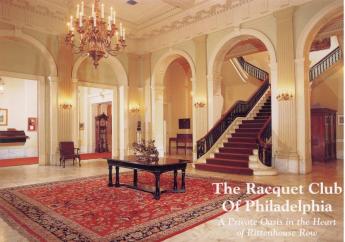Related Topics
West of Broad
A collection of articles about the area west of Broad Street, Philadelphia, Pennsylvania.
Particular Sights to See:Center City
Taxi drivers tell tourists that Center City is a "shining city on a hill". During the Industrial Era, the city almost urbanized out to the county line, and then retreated. Right now, the urban center is surrounded by a semi-deserted ring of former factories.
Widener, Stotesbury, and Trumbauer
Gerry McFadden devoted most of his short life to researching the history of Philadelphia clubs, but illness kept him from publishing much of it. Walton van Winkle has apparently taken up the role of club historian for the city, and much that survives to be known comes to us from them. For which we all ought to be grateful.

|
| Racquet Club |
The Racquet Club was once located at 9th and Walnut, just three blocks from the debtors prison at 6th and Walnut where the game of squash racquets is said to have originated. In 1906 it was decided to build a new club at 16th and Chancellor Streets; that did come to pass, largely because of three members. Henry Widener had taken a small inherited fortune and blown it up into a large personal fortune by monopolizing the trolley business in town. Edward T. Stotesbury, a much younger man, had ascended to the Presidency of Drexel and Company, in affiliation with J. P. Morgan. Both of these tycoons had built awesome mansions in the suburbs, one called Whitemarsh for where it was located, and the other called Lynnewood, on the grounds of what is now a huge apartment complex at the north end of Broad Street.Horace Trumbauer was the architect for both of these palaces, bringing together two men of considerably different age and personality. The conviction grew that Philadelphia needed a really first-class athletic club, and in 1906 it got built. Architect Trumbauer saw the whole design as related to the terrifying weight of the swimming pool full of water, and the indoor tennis courts, faced with thick slabs of slate. Builders who understand these things are impressed with the concept of a central tower to carry the internal weight of the building. The whole internal guts of the place are supported by steel girders of the type used to build bridges, ultimately resting on holes in the bedrock drilled 26 feet deep. If someone comes our way with an atom bomb, this is a good place to be a member.
The Racquet Club has one of the four or five Court Tennis areas in America, an interesting thing to look at, although the rules of the actual game are as baffling as those of cricket.
Another notable sight is the men's dressing room, wood-paneled and luxurious enough to be the scene of several movies. The shower heads, in particular, dump hot water on you like a Turkish Bath.
The Racquet club was always primarily for young men and tended to be a little raucous. It used to be said that almost anybody could be admitted -- you can take that for what it is probably worth -- but then the young members were carefully observed for their behavior, particularly in whom they married. If they seemed to be the right sort, they could then be invited into the Rittenhouse or the Philadelphia Club.
Originally published: Thursday, June 15, 2006; most-recently modified: Wednesday, May 22, 2019